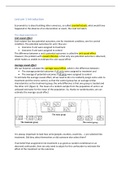Week 1 | Corporate Strategy and Diversification
What is strategy? Is the art of outperforming rivals in a dynamic competitive environment over
long periods of time
Two Levels of Strategy
● Corporate vs Business Strategy
●
● Corporate strategy
○ Choosing scope – Where to compete? (Products, geographies, customers…)
● Business strategy is about how we gain competitive advantage
Corporate strategy
“Corporate strategy is the pattern of decisions in a company that determines and reveals
its objectives, purposes, or goals, and defines the range of businesses the company is to pursue
[Lecture 1,4], the kind of economic and human organization it is or intends to be [Lecture 5,6], and
the nature of the economic and noneconomic contribution it intends to make to its shareholders,
employees, customers, and communities [Lecture 2,3].” (Andrews in Foss, 1997, p 52.)
- Theories of strategy focuses mostly on single businesses
- What businesses to compete in?
- How should the business strategies of the individual units be integrated and managed?
The Triangle of Corporate Strategy
resources, businesses, organization
Corporate Strategy:
- Is guided by a vision of how a firm, as a whole, creates value.
- Is a system of interdependent parts (not a collection of individual parts).
- Must be consistent with, and capitalize on, opportunities outside the company
1
, - Alignment of these elements is the source of corporate advantage.
Acid test for any corporate strategy: The company’s businesses must not be worth more to another
owner. Is the corporation the best owner?
- Can Unilever create more value for Dove than P&G?
● This underlines premises of corporate strategy
Premises of Corporate Strategy***(Important for exam)
● Competition occurs at the business level
○ Corporations don’t really compete, they strategically decide the plan. It’s the
businesses. Not Unilever competing with Beiersdorf. But Dove is competing with
Nivea.
● Being part of a diversified company involves inevitable costs for business units
○ Not everyone gets the newest or most expensive thing. Budgeting. (e.g. kids with
getting macbook from parents)
● Shareholders can diversify directly at a lower cost
○ There needs to be ability to create value. Otherwise the risk is just spread. That’s not
enough.
○ People who have Unilever shares because of ice cream, can also buy other stocks
from Nestle for Nescafe.
○ Shareholders having diversified portfolios.
Premises of Corporate Strategy
- 1+1>2
- 1+1=2
- 1+1<2
● (when the premises are achieved we get synergies)
The central issue in corporate strategy is how the corporation adds competitive value to its
businesses by creating synergies.
Parenting advantage (Feldman, 2021)
The best parent companies create more value in their businesses than rivals would.
● While good parents are always fine-tuning their parenting, they rarely change in any
fundamental ways.
● Being best compared to any potential other owner. Unilever being the best parent to Dove.
Family analogy (parents/kids)
Parent’s skills, resources, processes + Business’ needs and opportunities → fit = parenting value
2
, If a parent company is to own a particular business, not only must it be able to add value to
that business but also it should be capable of adding more value than any other potential parent.
Parenting value creation explains the presence of corporations.
Corporate Diversification
What is diversification?
- Growth strategy
- When a firm simultaneously engages in multiple business activities, products, or country
markets.
- Successful diversification: To achieve successful diversification a company must first take
an objective look at its existing businesses and the value added by the corporation… That
understanding should guide future diversification as well as the development of skills and
activities with which to select further new businesses.
- Parents being the best owner to the business.
- Diversification as an avenue for growth:
- This growth actually destroys value for some.
- Larger = Bigger thinking destroys value.
- Motives for diversification
1. Growth. (but be aware of the costs of entry into a different product market!)
2. Spreading risk (by combining businesses with uncorrelated financial flows (Palich
et al., 2000) - but limited value creation!
a. Unilever, which owns Ben & Jerry, sells ice cream only in summer. For
Winter, they can find ways to grow either they go to Australia for summer
-internationalization- or they can stay in Europe and enter the coffee
business.
b. Destroys value because shareholders can diversify themselves.
c. Diversification as a growth strategy oftentimes goes bad.
3. Value creation (Palich et al., 2000)
a. Economies of scope: sharing resources and capabilities across multiple
businesses along the value chain
i. Kraft producing Oreo’s and LU at the same time. Buying wheat for
more than 1 product.
ii. Economies of scope is a way to create value through diversification
b. Economies of scale: producing the same single product. Unit cost
decreasing.
c. Economies from Internalizing Transactions: (from the article)
i. Internal capital markets: Google becoming Alphabet
3
, ii. Internal labor markets
Good, Bad & Ugly Reasons Why Firms Diversify (Montgomery, 1994)
- Resources View
- Excess capacity in productive factors (+indivisibilities)
- Firm learning
- Economies of scope
- Agency View
- Empire building
- Managerial entrenchment
- Reduce employment risk
- Market Power View
- Increase bargaining power
- Cross-subsidization
- Mutual forbearance
- Risk & Control View
- Co-insurance of risks
- Revenue stability
- Address market failures
- Transaction costs of mkt > coordination & bureaucratic costs within firm
● Diversification should be in the interest of shareholders, not the managers!
○ Managerial hubris: Believe that managers can manage unrelated businesses
○ Empire making: Managers wanting to create this big empire, many businesses and
be the manager for that.
Diversification and Performance (Palich et al., 2000)
- Research has found that diversified firms do not always outperform non-diversified firms.
- Causality. Diversification ⇥?⇤ Profitability.
- Chicken & egg problem
- No consistent relationship BUT evidence of an inverted-U relationship.
- Curvilinear relationship between diversification and performance (Accounting and
market based): moderate levels of diversification lead to higher levels of
performance than either limited or extensive diversification.
-
- After breakpoint diversification destroys value. It becomes hard to share
resources. Moving from related diversification to unrelated diversification.
4
What is strategy? Is the art of outperforming rivals in a dynamic competitive environment over
long periods of time
Two Levels of Strategy
● Corporate vs Business Strategy
●
● Corporate strategy
○ Choosing scope – Where to compete? (Products, geographies, customers…)
● Business strategy is about how we gain competitive advantage
Corporate strategy
“Corporate strategy is the pattern of decisions in a company that determines and reveals
its objectives, purposes, or goals, and defines the range of businesses the company is to pursue
[Lecture 1,4], the kind of economic and human organization it is or intends to be [Lecture 5,6], and
the nature of the economic and noneconomic contribution it intends to make to its shareholders,
employees, customers, and communities [Lecture 2,3].” (Andrews in Foss, 1997, p 52.)
- Theories of strategy focuses mostly on single businesses
- What businesses to compete in?
- How should the business strategies of the individual units be integrated and managed?
The Triangle of Corporate Strategy
resources, businesses, organization
Corporate Strategy:
- Is guided by a vision of how a firm, as a whole, creates value.
- Is a system of interdependent parts (not a collection of individual parts).
- Must be consistent with, and capitalize on, opportunities outside the company
1
, - Alignment of these elements is the source of corporate advantage.
Acid test for any corporate strategy: The company’s businesses must not be worth more to another
owner. Is the corporation the best owner?
- Can Unilever create more value for Dove than P&G?
● This underlines premises of corporate strategy
Premises of Corporate Strategy***(Important for exam)
● Competition occurs at the business level
○ Corporations don’t really compete, they strategically decide the plan. It’s the
businesses. Not Unilever competing with Beiersdorf. But Dove is competing with
Nivea.
● Being part of a diversified company involves inevitable costs for business units
○ Not everyone gets the newest or most expensive thing. Budgeting. (e.g. kids with
getting macbook from parents)
● Shareholders can diversify directly at a lower cost
○ There needs to be ability to create value. Otherwise the risk is just spread. That’s not
enough.
○ People who have Unilever shares because of ice cream, can also buy other stocks
from Nestle for Nescafe.
○ Shareholders having diversified portfolios.
Premises of Corporate Strategy
- 1+1>2
- 1+1=2
- 1+1<2
● (when the premises are achieved we get synergies)
The central issue in corporate strategy is how the corporation adds competitive value to its
businesses by creating synergies.
Parenting advantage (Feldman, 2021)
The best parent companies create more value in their businesses than rivals would.
● While good parents are always fine-tuning their parenting, they rarely change in any
fundamental ways.
● Being best compared to any potential other owner. Unilever being the best parent to Dove.
Family analogy (parents/kids)
Parent’s skills, resources, processes + Business’ needs and opportunities → fit = parenting value
2
, If a parent company is to own a particular business, not only must it be able to add value to
that business but also it should be capable of adding more value than any other potential parent.
Parenting value creation explains the presence of corporations.
Corporate Diversification
What is diversification?
- Growth strategy
- When a firm simultaneously engages in multiple business activities, products, or country
markets.
- Successful diversification: To achieve successful diversification a company must first take
an objective look at its existing businesses and the value added by the corporation… That
understanding should guide future diversification as well as the development of skills and
activities with which to select further new businesses.
- Parents being the best owner to the business.
- Diversification as an avenue for growth:
- This growth actually destroys value for some.
- Larger = Bigger thinking destroys value.
- Motives for diversification
1. Growth. (but be aware of the costs of entry into a different product market!)
2. Spreading risk (by combining businesses with uncorrelated financial flows (Palich
et al., 2000) - but limited value creation!
a. Unilever, which owns Ben & Jerry, sells ice cream only in summer. For
Winter, they can find ways to grow either they go to Australia for summer
-internationalization- or they can stay in Europe and enter the coffee
business.
b. Destroys value because shareholders can diversify themselves.
c. Diversification as a growth strategy oftentimes goes bad.
3. Value creation (Palich et al., 2000)
a. Economies of scope: sharing resources and capabilities across multiple
businesses along the value chain
i. Kraft producing Oreo’s and LU at the same time. Buying wheat for
more than 1 product.
ii. Economies of scope is a way to create value through diversification
b. Economies of scale: producing the same single product. Unit cost
decreasing.
c. Economies from Internalizing Transactions: (from the article)
i. Internal capital markets: Google becoming Alphabet
3
, ii. Internal labor markets
Good, Bad & Ugly Reasons Why Firms Diversify (Montgomery, 1994)
- Resources View
- Excess capacity in productive factors (+indivisibilities)
- Firm learning
- Economies of scope
- Agency View
- Empire building
- Managerial entrenchment
- Reduce employment risk
- Market Power View
- Increase bargaining power
- Cross-subsidization
- Mutual forbearance
- Risk & Control View
- Co-insurance of risks
- Revenue stability
- Address market failures
- Transaction costs of mkt > coordination & bureaucratic costs within firm
● Diversification should be in the interest of shareholders, not the managers!
○ Managerial hubris: Believe that managers can manage unrelated businesses
○ Empire making: Managers wanting to create this big empire, many businesses and
be the manager for that.
Diversification and Performance (Palich et al., 2000)
- Research has found that diversified firms do not always outperform non-diversified firms.
- Causality. Diversification ⇥?⇤ Profitability.
- Chicken & egg problem
- No consistent relationship BUT evidence of an inverted-U relationship.
- Curvilinear relationship between diversification and performance (Accounting and
market based): moderate levels of diversification lead to higher levels of
performance than either limited or extensive diversification.
-
- After breakpoint diversification destroys value. It becomes hard to share
resources. Moving from related diversification to unrelated diversification.
4










